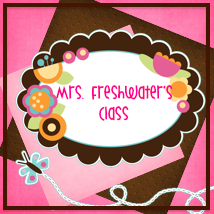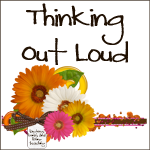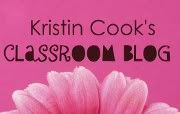
ONLY ABOUT A 1.5 WEEKS LATE! =)
BLOG HOP HOSTS: Check out Mrs. Freshwater's Class blog for Melissa's chapter 3 thoughts and Reading and Thinking Out Loud for Jana's chapter 3 thoughts.


ESTABLISHING A GATHERING PLACE
I'm sure I'm not the only 1st grade teacher that has carpet time. . . but the majority of our carpet time is used for me teaching and the students listening and responding. Each day in many lessons we do a "think-pair-share" but this is sparse in comparison to the lesson time.
The Daily 5 difference to me was that it is a safe and "easy" way for students' brains to get "unstuck" and enter into a new task. When I say easy, it is meant so that it is an easy transition for the brain to make as it is non-threatening and offers a place for the possibility of new learning.
(Although I am not as fluid with my words as Gail and Joan.)
I also like how it is student-centered, which allows for ownership of the time and place while also building a collaborative community of learners.
GOOD-FIT BOOKS
What can I say? The idea is very creative! I like how they continued with the "shoe" example. I agree that the "Good-Fit" books need to be year-long lessons and not just a "flash in the pan".
After reading this section, for me the most challenging part of implementing good-fit books will be when students get to pick out their own books. I have anxiety already about them rushing through the books, covers flying through the air, and tug-o-war ensuing between who gets the "cool" shark book. However, I'm trusting the theory and am going with it at this point. I have to ask myself, "How else do you think you will be successful in implementation if you don't 'let go' of these controlling habits?" It's true. . . all teachers are "control-freaks" to some degree (and I say this with love and kindness because I am probably the top 1%!)
I am anxious in a good way about the one-on-one conferences. This seems to really help teachers get to know their students' in a more personal reading context.
SETTING UP BOOK BOXES
I think I need to start saving cereal boxes!
Providing students with a "start-up pack" allows you to see where students "fit" with books while also making a personal connection with the students. This seems easy to implement and since you only have to prep the boxes on the 1st day, then it's easy as pie! (I may be eating my words later. . . .)
I can't tell you how long it's been since I've updated by classroom library! I feel stuck in a rut. This is the conversation I have with myself. . .
"Why bother buying new books? They will end up bent, ripped, not in the right book bin and at some point they will get lost. Plus I won't remember what I bought anyway and don't have time to do a read aloud with all the other stuff that I have to get done!"I'm hoping that through the Daily 5, I will have more ways to set-up my books/classroom library to make text more accessible for the students.
ANCHOR CHARTS
OK people. . . I need to get on the ball here! When I was doing my methods placement in under-grad. I had one of the best teachers. She had anchor charts attached to a loooooooong rope that went diagonal through her classroom. It is exactly what I pictured when I read this section of the book!
Now that I teach brain-based reading instruction which focuses on a lot of mind-mapping and visual input. . . I can see even more merit to anchor charts. They are a great tool in making neural connections while also cementing learning with visual input through the use of multiple colors, varying text size, and providing illustrations/pictures of the concept or skill.
Also, I really liked how Gail and Joan never throw away the anchor charts! It makes so much sense! I am the teacher that changes out my posters throughout the school year in order to provide new visual material that also matches the students learning growth. However, by creating the anchor charts together and by adding more and more throughout the year, students are able to create connections across multiple skills/strategies and discuss these charts with their peers.
I know on many occasions the "stuff" that is most meaningful in my classroom are the charts/posters/etc. that the students and I made either as a group or individually. I have overheard students talking to one another saying,
Student 1:"Remember when we did this?"
Student 2: "Yeah, I do! We were reading that story about a fox."
Student 1: "That ending was really funny. It was like that other book."
Often students then begin reading the chart and talking a bit more about it. This is something that I overlooked until now!
A question that still remains is. . . why are there so many pinterest and blog posts out there offering ideas on how to store anchor charts from year to year? If the purpose of anchor charts is to cement learning in the brain and create neural connections, doesn't this type of "storage" defeat the purpose? Don't they just become another poster on the wall?
SHORT INTERVALS OF REPEATED PRACTICE
The key idea that spoke to me about this section was the importance of "perfect practice". Without this, your Daily 5 approach is DONE! Once students see that your expectations have slipped, it is like a free-for-all! However, if they know exactly what is expected and that they can do it, then you are one step closer to successful Daily 5 implementation.
On a side note, the kinesthetic section is so smart! I like how they created the Ten Steps to Improve Muscle Memory.
SIGNALS AND CHECK IN
The chimes are very non-threatening but also attention-grabbing enough to prevent the brain from entering into the "fight or flight" mode. Although I do not have chimes, I do have A chime that I plan on using. At the beginning of the year, I often teach classroom expectations by using both good and bad behavior examples. The students love being "bad"! The point that I liked was that when they made their anchor chart, they included EVERYONE'S ideas . . . . even off-topic ones. How many times have you censored a students' idea when you wrote it down? Come on. . . . admit it. . . . you've done it at least once. . . this is also important to note because in order to create ownership and acceptance, you must model accepting all student's ideas/thoughts!
CHECK-IN: Anyone else think of "THE FONZ"?
Life-long learners need to be self-reflective . . . METACOGNITIVE about their learning! The thumbs-up/thumbs-sideways is a quick positive self-assessment for students and teachers.
CORRECT MODEL/INCORRECT MODEL
This ties in with the repeated practice. Students love acting "bad"! It is also a great way for them to remember exactly what to do. It seems to echo the Frayer Model a tad bit!
I like how they use a more challenging student to model the expected behavior. Generally speaking, these students primarily learn through kinesthetic modalities. Therefore, through this modeling process, he/she is cementing expected behaviors in his/her memory!
I would probably like to add to the I-Charts a photo of the expected behavior.
That's all from me for Chapter 3! Thanks so much for reading this! Looking forward to Chapter 4!







































1 comments:
Hi! I've given you the One Lovely Blog award over in my latest post, come check it out! :)
Post a Comment